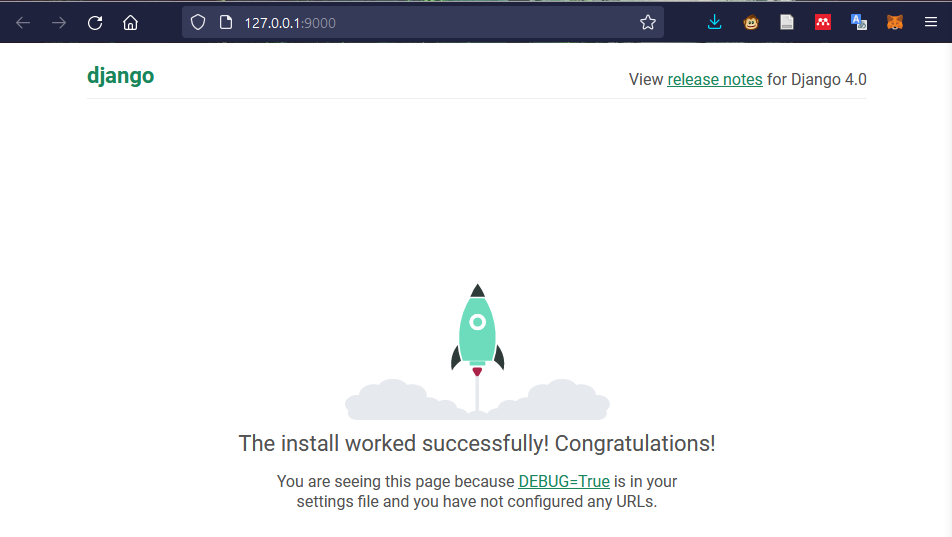Django-based Payment Service v1.0
pip 3 install pipenv
pipenv install django
pipenv shell
With a suffix ".", we are telling django to use the current projectname as current main directory
django-admin startproject paymentservice .
Please refer to the following link: >> https://django-project-skeleton.readthedocs.io/en/latest/structure.html
without having runserver error for django, we use the following command on teh manage.py which is the app WRAPPER with a custom port number e.g. 9000
python manage.py runserver 9000
- (Ctrl+Shift+P) on VSCode
- get the actual environment URL
pipenv --venv
copy the path e.g. "C:\Users\rmastour.virtualenvs\django_Payment_Service-hKmBDVso"
- install interpreter path (Ctrl+Shift+P) and type
>python: select Interpeter
by pasting the latter path "C:\Users\rmastour.virtualenvs\django_Payment_Service-hKmBDVso\bin\python"
- use the + sign on top right corner of terminal to open as many terminals as you wish
- (CTRL+L) to clear the window
- run this command
python manage.py startapp playground
- Go back to the project setting.py and add the app name
'playground', #here to add the newest app to settings.py
# Create your views here.
# A view function is a function that takes a request and return a response
# request -> response
# More accurately, it is a request handler
# in some other frameworks, it is called an "Action"
# from architecture point of view, a view is often assosiated with somethign that user sees
# That part in Django is called "Template"
def say_hello(request):
#What we can do is the following
'''
1. Pull data from a DB
2. Transfrom data
3. send an email
4. and so on..
'''
reponse = HttpResponse('Hello there!') #this one needs to be mapped to a URL
#So when we get a request at that URL, this function will be called
return reponse
- in the project folder, let's create a file called "urls.py"
from django.urls import path
#from current folder, import views
from . import views
'''
Now we declare a special variable called urlpatterns
'''
# Here we have a so-called URLConf
#playground/hello
urlpatterns = [
path('hello/', views.say_hello)
]
- Now we go to the main urls.py of the project
from django.contrib import admin
from django.urls import path
# now let's add these libraries
from django.contrib import admin
from django.urls import path, include
from playground import views
urlpatterns = [
path('admin/', admin.site.urls),
path('playground/', include('playground.urls')), #newly added
]
- in app folder, let's create another folder called "templates"
- in "templates" we add a new html file called "hello.html"
<h1>{{name}}'s Portfolio Section:</h1>
- back to view function, instead of returning HttpResponse('string blabla'), we will use the render function to render a template and return a html markup to the client
- in views.py
def say_hello(request):
#What we can do is the following
'''
1. Pull data from a DB
2. Transfrom data
3. send an email
4. and so on..
'''
#reponse = HttpResponse('Hello there! I work for Fulcrum Digital Inc.') #this one needs to be mapped to a URL
#So when we get a request at that URL, this function will be called
#render html
reponse = render(request, 'hello.html', {'name': 'Reda'}) # we add 3rd params as dictionary
return reponse
- Click "Run and Debug Panel" on VSCode
- Click on "Create a launch.json file"
- in the popped-up list, choose "Django"
- The code looks lke:
{
// Use IntelliSense to learn about possible attributes.
// Hover to view descriptions of existing attributes.
// For more information, visit: https://go.microsoft.com/fwlink/?linkid=830387
"version": "0.2.0",
"configurations": [
{
"name": "Python: Django",
"type": "python",
"request": "launch",
"program": "${workspaceFolder}\\manage.py",
"args": [
"runserver",
"9000"
],
"django": true
}
]
}
- install via pipenv
pipenv install django-debug-toolbar
- add 'debug_toolbar', in the installed INSTALLED_APPS
- CTRL+P to bring the seacrh box and search for settings.py
INSTALLED_APPS = [
'django.contrib.admin', #give admin interface to manage the data
'django.contrib.auth', #this used to authenticate the users in the app
'django.contrib.contenttypes',
#'django.contrib.sessions', #this manages the user's data
'django.contrib.messages', # used to display notification to the user
'django.contrib.staticfiles', # this to manage the static files like CSS and images
# we also need to add all the newly created apps in here ~ Reda
'playground', #here hour first beta app
'debug_toolbar', #for debugging
]
- Adding a new path to the URLConf module of the project folder
urlpatterns = [
path('admin/', admin.site.urls),
path('playground/', include('playground.urls')), #newly added
path('__debug__/', include('debug_toolbar.urls')), #newly added
]
- Enabling a middleware to hook into django's request response processing. In our settings module we have a setting called MIDDLEWARE
MIDDLEWARE = [
'debug_toolbar.middleware.DebugToolbarMiddleware', #Newly added for debugging
'django.middleware.security.SecurityMiddleware',
'django.contrib.sessions.middleware.SessionMiddleware',
'django.middleware.common.CommonMiddleware',
'django.middleware.csrf.CsrfViewMiddleware',
'django.contrib.auth.middleware.AuthenticationMiddleware',
'django.contrib.messages.middleware.MessageMiddleware',
'django.middleware.clickjacking.XFrameOptionsMiddleware',
]
- Configuring Internal IPs:
#Configuring Internal IPs
INTERNAL_IPS = [
# ..
'127.0.0.1',
# ..
]
